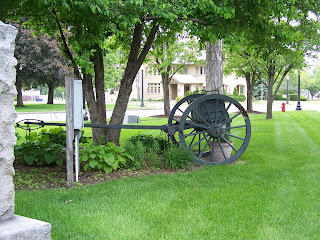 |
| Taken from Soldier's monument across the street. |
 |
| Closer view |
 |
| Limber from the front |
 |
| Limber from the side |
Plaques posted give a short history of the unit, along with the names of the men in the battery.
 |
| Unit history Plaque |
 |
| Names Plaque 1 of 3 |
 |
| Names Plaque 2 of 3 |
 |
| Names Plaque 3 of 3 |
For a slightly more detailed unit history, I went to the Soldiers and Sailors database maintained by the National Park Service. That history can be found at the end of the post. The Soldiers and Sailors database can be found at: https://www.nps.gov/civilwar/soldiers-and-sailors-database.htm
Finally, a there is a monument to the town of Coldwater itself.
 |
| Coldwater Monument sign |
Other monuments have been placed in the park, but they pertain to later eras and thus are beyond the scope of this blog.
-Corporal
1st Regiment, Michigan Light Artillery
- Overview:
- BATTERY "A" 1st REGIMENT LIGHT ARTILLERY. ("LOOMIS' BATTERY," "COLDWATER ARTILLERY.")
Attached to State Militia. Tendered its services to the government as an organization and accepted by the government April 23, 1861. On duty at Fort Wayne; Detroit, Mich. Battery reorganized for three years service and mustered in May 28, 1861. Left State for Cincinnati, Ohio, May 31. Duty at Camp Dennison, Ohio, till June 12. Ordered to West Virginia June 12. Attached to McCook's Brigade, Army of Occupation, West Virginia, to August, 1861. Reynolds' Cheat Mountain District, West Virginia. to December, 1861. Artillery, 3rd Division, Army of the Ohio, to September, 1862. 17th Brigade, 3rd Division, 1st Corps, Army of the Ohio, to November, 1862. 2nd Brigade, 1st Division, Center 14th Army Corps, Army of the Cumberland, to January, 1863. Artillery, 1st Division, 14th Army Corps, Army of the Cumberland, to December, 1863. Garrison Artillery, Chattanooga, Tenn., Dept. of the Cumberland, to July, 1865. - Service:
- At Clarksburg, W. Va., June 28, 1861. March to Buckhannon June 28-July 1. Middle Fork Bridge July 6. Camp Garnett, Rich Mountain, July 10. Battle of Camp Garnett, Rich Mountain, July 10-11. Battery remounted with six 10-lb. Parrotts by order of the General commanding. At Beverly July 12. Moved to Cheat Mountain Pass July 13, thence to Elkwater August 14 and duty there till October 30. Operations on Cheat Mountain September 11-17. Point Mountain Turnpike and Cheat Mountain Pass September 13. Elkwater September 14. Greenbrier River October 3-4. Moved to Huttonsville October 30, thence to Phillippi December 6. Ordered to Louisville, Ky., December 16; thence to Bacon Creek December 31 and duty there till February, 1862. Advance on Bowling Green, Ky., February 14-15. Occupation of Bowling Green February 15. Advance on Nashville, Tenn., February 22-25. Occupation of Nashville February 25. Engaged in scout and patrol duty in Northern Alabama by detachments and at Edgefield, Tenn., till August. Action at Bridgeport, Ala., April 29. Gunter's Landing May 15 (Detachment). Athens May 29 (Detachment). Whitesboro June 13 (Detachment). Expedition from Woodville to Guntersville July 27-30 (Section) - March to Nashville, Tenn., thence to Louisville, Ky., in pursuit of Bragg August 21-September 26. Pursuit of Bragg to Crab Orchard, Ky., October 1-15. Battle of Perryville, Ky., October 8. March to Nashville, Tenn., October 16-November 7, and duty there till December 26. Advance on Murfreesboro, Tenn., December 26-30. Battle of Stone River December 30-31, 1862, and January 1-3, 1863. Duty at Murfreesboro till June. Expedition to McMinnville April 20-30. Middle Tennessee (or Tullahoma) Campaign June 23-July 7. Hoover's Gap June 24-26. Occupation of Tullahoma July 1. Occupation of Middle Tennessee till August 16. Passage of the Cumberland Mountains and Tennessee River and Chickamauga (Ga.) Campaign August 16-September 22. Davis Cross Roads, near Dug Gap, September 11. Battle of Chickamauga September 19-21; 5 pieces captured after 27 Officers and men and 50 horses had been killed and disabled; one with 3 caissons was recaptured on September 19, and two more on the 20th, but all were unfit for duty and the Battery was ordered to Chattanooga; one gun was recaptured at Mission Ridge and the last at Atlanta. Siege of Chattanooga, Tenn., September 24-November 23. Battles of Chattanooga November 23-25. Battery stationed at Chattanooga as garrison till July, 1865. Demonstration on Dalton February 22-27, 1864 (Section). Tunnel Hill, Buzzard's Roost Gap and Rocky Faced Ridge February 23-25, 1864. Mustered out July 12, 1865, and discharged at Jackson, Mich., July 28, 1865.
Battery lost during service 1 Officer and 11 Enlisted men killed and mortally wounded and 28 Enlisted men by disease. Total 40.











